

Defense of the farmstead against robber, fox, and coyote was the province of the shotgun, primarily. These cartridges, and the compact and inexpensive Iver Johnsons, Harrington & Richardsons, and various trade brand guns that chambered them, were for carry and self-defense above all else. “Hunting” also was possible, only if you counted shooting an occasional varmint you couldn’t knock over the head with a stick or ax handle. 38 S&W were not for sporting or hunting purposes primarily, although sport was to be had–if funds allowed–shooting at cans, bottles, or marks on a tree. To the old-time farmer or tradesman of the break-top revolver era, a gun was a necessary tool with a specific purpose unlike any other. If we focus too hard on those aspects, however, we lose sight of the fact that guns are tools. We may see guns as works of art and mechanical wonder, to be treasured as such. We will never see its like again.Ī well-conceived article that expresses some important truths that many of us gun & shooting hobbyists ignore or forget. The cheap, low-tech Owl Head was a raging success for its intended purpose. If a farmer or shopkeeper was known to carry an Owl Head, nobody was in an itching hurry to push his buttons. The outside lubed lead bullets picked up everything except women and money, and even a superficial wound almost guaranteed a raging infection, if not outright sepsis, which…in the days before effective, broad-spectrum antibiotics…sentenced many people to a slow, agonizing death.Įveryone understood this, and they were rightfully afraid of being on the wrong end of an Owl Head, which made them an effective deterrent to any foolishness. What they were was nasty to get shot with. 38 S&W…very powerful by today’s standards. Neither were the two most popular calibers…namely. They just wouldn’t come apart in your hand when fired with smokeless ammunition. The 3rd Models were proofed for smokeless powders, but weren’t much more durable than their two older cousins. Today, finding a working example of a 1st or 2nd Model is rare, but it’s also moot because proper ammunition loaded with black powder is scarce, and most of the stuff loaded with modern smokeless powder is hard to come by and expensive as well as being unsafe to fire in the 1st and 2nd Models. These charming little guns were strictly business, and they filled that niche very well. No, they weren’t very durable, and they didn’t stand up well to a lot of use, but with ammunition so frightfully expensive…nobody could afford to shoot for recreation and they weren’t especially accurate anyway. With the Owl Head, Iver Johnson made it possible for people of limited means to have a reliable revolver for personal defense without having to forego eating for a month. While three dollars in 1914 was a considerable sum to a man who earned a whole dollar a day digging coal or laboring on a farm, it was a smoking deal when a Colt or a Smith & Wesson would set you back 25 or 30 dollars. In 1914, the year my salty old pappy was born, they could be purchased from a local hardware or feed store for less than three US dollars, and the proprietor would often throw in a 40-cent box of ammunition to cinch the deal. With wrought iron frames and low carbon steel cylinders and barrels the Iver Johnson Owl Heads weren’t very strong or durable, but they were cheap. 38 S&W that was still actually functional…which means that it wasn’t fired very much in the last hundred or so years. During one of my rare sojourns away from Castle Doghair, I was privileged to encounter an old First Model Iver Johnson Owl Head revolver in caliber.


 0 kommentar(er)
0 kommentar(er)
